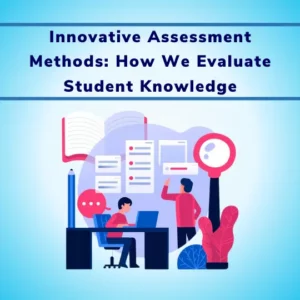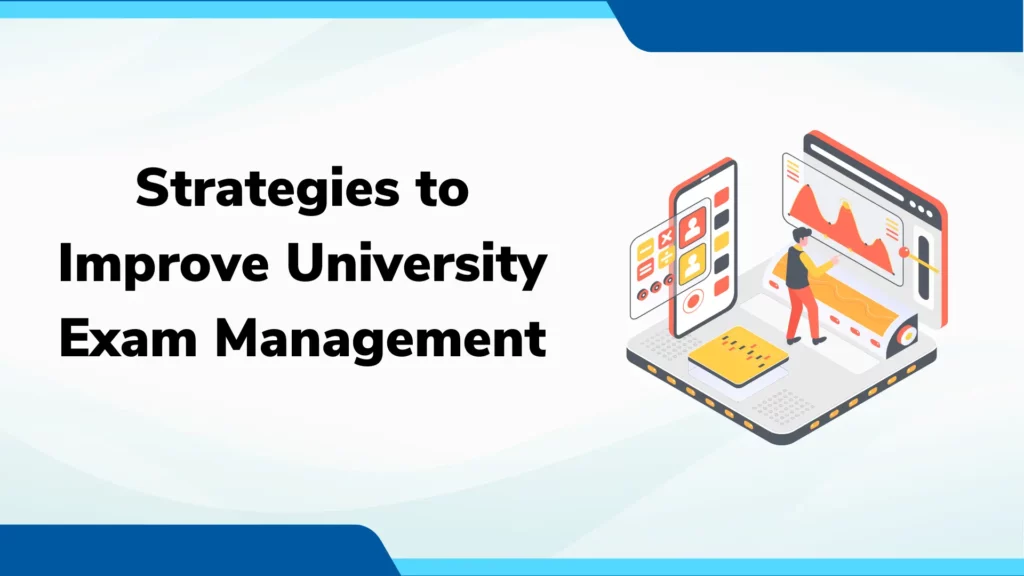
Article Contents
Introduction
The university examination management staff faces a range of complex challenges that significantly affect efficiency, security, and the overall education experience. Conventional ways of manually conducting exams, such as paper-based exams and manual result processing, result in prolonged processes, possible inaccuracies, and unnecessary delays.
The task of ensuring an unbiased and secure evaluation can become daunting, especially in case of exams conducted on a large scale. Moreover, as students seek easy digital experiences, the difference between what they expect and how exams are traditionally conducted are way too many. Owing to this, the traditional ways of conducting exams are in need of a transformation.
A survey found that 72% of educational institutions plan to increase their investment in educational technology over the next five years
To meet the demands of today’s digital age, universities need to simplify and modernize their examination management systems. Transitioning from paper-based exams to online platforms can eliminate many challenges by streamlining processes and reducing errors.
It not only offers convenience to students but also enhances the overall examination ecosystem. Adopting advanced technologies such as Artificial Intelligence and Machine Learning, becomes imperative for ensuring exam integrity, security, and a seamless experience for all stakeholders.
In this article, we delve into innovative solutions that can reshape university examination management. We explore the benefits of transitioning to online examination systems, which offer enhanced security, reduced administrative burdens, and quicker result processing.
We also discuss the potential of AI-driven tools in automating various aspects of exam management, from question paper generation to cheating detection.
Let us see how universities can elevate their examination management to match the expectations of today’s tech-savvy students and administrators by addressing the challenges of traditional examinations with the help of cutting-edge solutions.
1) Embracing Technology in Question Paper Creation
Traditional question paper creation often involves manual efforts, including selection of questions from various sources, their arrangement, and ensuring coverage of topics and difficulty levels. But this process is time-consuming, prone to errors, and lacks flexibility for customization.
It also limits the variety of question formats that can be included in the paper. Moreover, making quick updates or modifications is difficult in case of traditional, leading to outdated or irrelevant questions.
It also limits the variety of question formats that can be included in the paper. Moreover, making quick updates or modifications is difficult in case of traditional, leading to outdated or irrelevant questions.
Technology offers transformative solutions to question paper creation by automating and streamlining the process. Advanced platforms allow teachers to easily create question banks by selecting questions based on parameters like topic, difficulty, marks and format, and generate a well-structured paper in a fraction of the time.
The integration of AI enhances the process further by suggesting suitable questions based on learning objectives and analyzing question patterns. This technology-driven approach is efficient and precise in crafting question papers.
Benefits of using technology for question paper creation
Embracing technology for question paper creation has numerous advantages. It accelerates the entire process and enables teachers to focus more on education delivery. Technology allows for dynamic modifications, ensuring that question papers are always up-to-date and relevant. As technology allows diverse question formats, the question papers can cater to different learning styles and assessment objectives.
Moreover, the algorithms used for question paper creation promote consistency in terms of difficulty level and coverage of topics. Ultimately, this modern approach helps educators to craft well-crafted, balanced, and effective question papers that align perfectly with educational goals.

2) AI in Question Paper Generation
Introduction to AI and its potential in education
Artificial Intelligence (AI) is a powerful tool that is transforming various fields, including education. When it comes to curating question papers, AI can make things better, rather simpler. AI can look at data, find patterns, and make informed decisions, which helps create accurate and effective question papers that suit diverse learning needs.
In a study, 80% of faculty members reported that online exams have improved the quality of their assessments.
How AI can be used in question paper generation?
AI technology can revolutionize question paper generation by automating the process. It can analyze course content, learning objectives, and assessment criteria to suggest suitable questions. AI algorithms can enhance the overall quality of the question paper by following all the question paper parameters. Additionally, AI can adapt to changes in the curriculum and incorporate feedback from teachers which would lead to relevant question papers generation.
Benefits of AI in question paper generation
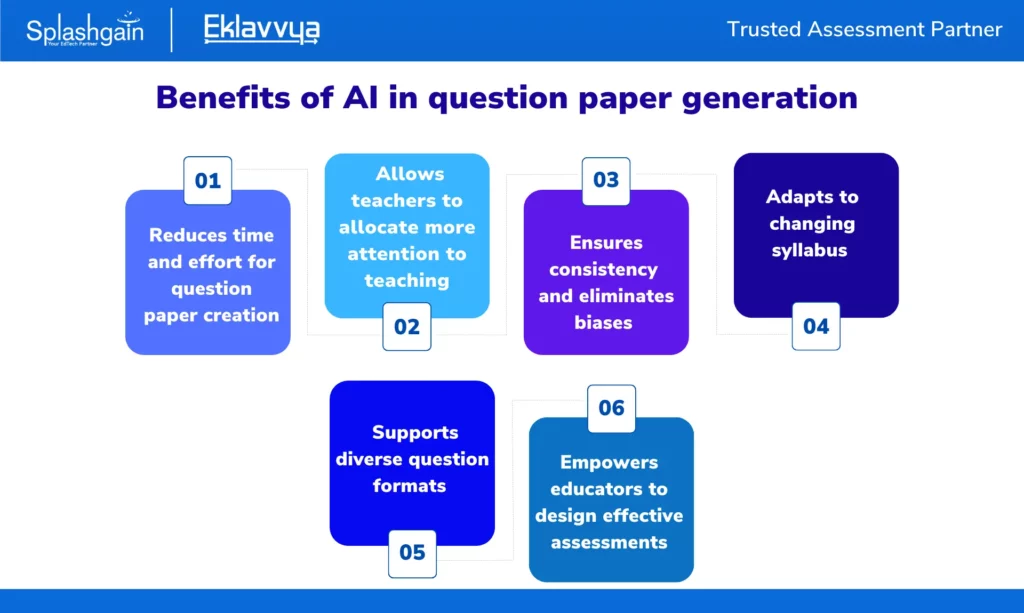
The integration of AI in question paper generation offers numerous benefits. It significantly reduces the time and effort required to create question papers, allowing teachers to focus on other aspects of teaching. AI-driven question paper generation ensures consistency and eliminates biases in question selection.
The technology’s adaptability to changing syllabus ensures that question papers remain aligned with evolving educational standards. Moreover, AI supports diverse question formats that cater to various learning styles. Ultimately, AI empowers educators to design effective question papers that effectively evaluate students’ understanding and knowledge.
3) Streamlining Entrance Exam Management
Complexities in managing entrance exams
Managing entrance exams for educational institutions involves a multitude of challenges, from logistics and security to result processing. Arranging exam centers, monitoring candidates, preventing malpractices, and ensuring a fair evaluation process are complex tasks that demand careful planning and execution. Moreover, manual processes can lead to errors, delays, and administrative burdens that affect the overall efficiency of the examination system.
Steps to simplify entrance exam management
A strategic approach can simplify entrance exam management. Leveraging technology can significantly reduce complexities.
In a survey, 80% of faculty members reported improved exam management after switching to online exams.
Implementing online registration and fee payment systems can help streamline candidate enrollment processes. Utilizing online exam platforms offer a scalable solution for conducting exams securely and efficiently.
Automating result processing and generation of merit lists further reduces manual intervention. By adopting such integrated systems, institutions can enhance the overall exam management experience for both administrators and candidates.
The use of technology in exam management can reduce administrative workload by up to 50%.
The role of technology in streamlining entrance exam management
Technology plays a pivotal role in simplifying entrance exam management. Online registration portals ensure smooth candidate registration and reduce paperwork and other human errors. Secure online exam platforms offer features like random question generation and remote proctoring that ensure fair and credible evaluations. Automated result processing and quick marksheet generation can expedite result announcements.
Moreover, the analytics generated by the online exam platforms provide insights into exam performance, aiding institutions in continuous improvement. By embracing technology-driven solutions, educational institutions can overcome the challenges of conducting online entrance exams with efficiency and precision.
4) Remote Proctoring: The Future of Examinations
Remote proctoring and its importance in the current scenario
Remote proctoring has emerged as a vital solution to ensure the integrity and credibility of online assessments, especially in the current era of remote learning. It involves supervising candidates appearing for exams remotely, thus avoiding the shortcomings in traditional exam centers. As remote education is becoming popular day by day, adopting remote proctoring is indispensable to prevent cheating and maintaining the validity of assessment outcomes.
How does Remote Proctoring work?
Remote proctoring utilizes advanced technology to monitor candidates during online exams. It may involve video and audio recording, image capture, and AI-powered algorithms to detect suspicious behaviors. Candidates’ actions and their surroundings are monitored in real-time. In case of any discrepancies, automated alerts are generated to enable invigilators to review flagged instances for possible violations. Thus, remote proctoring ensures exam security, while providing candidates the convenience of taking assessments from their preferred locations.
Potential concerns of remote proctoring and how AI can address them
There are concerns about privacy and potential technical glitches. Remote proctoring involves the use of cameras and microphones to monitor students, raising concerns about privacy violations and the collection of personal data. Technical issues such as internet connectivity problems or software malfunctions can disrupt the proctoring process, affecting both students’ performance and the integrity of the exam.
Students might face unexpected disruptions during the exam, such as background noises or disturbances, which could lead to unwarranted flags by the proctoring system. Students from different socio-economic backgrounds might not have access to the necessary technology or a suitable environment for remote proctoring, creating inequity in the assessment process.
AI utilizes advanced mechanisms and algorithms to safeguard students’ privacy. AI can detect technical glitches in real-time and offer instant solutions to ensure that technical issues do not disrupt the exam. AI can differentiate between intentional violations and unintentional disturbances, reducing the chances of false flags.
AI can be programmed to include diverse datasets to minimize biases and ensure fair treatment for all students, regardless of their background. AI can include accessibility features, such as text-to-speech and voice recognition, to ensure that students with different needs can comfortably take the exam.

5) Onscreen Marking: Simplifying Offline Exam Result Processing
The traditional process of exam result processing and its drawbacks
The traditional method of processing exam results involves manual evaluation, data entry, and result compilation. This process is not only time-consuming but also prone to errors and inconsistencies. The manual checking of answer scripts and handling data can lead to delays in result announcements.
Online exams can save up to 75% of the time required for exam result processing compared to traditional exams.
Thus, the overall efficiency of the examination process is affected due to manual efforts and human limitations.
Introduction to onscreen marking and how it works
Onscreen marking system revolutionizes the process of evaluation and result processing. It involves scanning the answer scripts which allows the teachers to evaluate and mark scripts on computer screens.
Studies suggest that onscreen marking can enhance marker accuracy by 15% and speed up the marking process by up to 30% (Source: University of Cambridge).
The digital format provides various tools for annotation and grading, enhancing accuracy and efficiency. It also reduces the chances of marking answers incorrectly or missing any answer from marking. Once marked, the results are automatically calculated by the software and recorded digitally. This eliminates manual efforts required for checking answer sheets, entering data and evaluating and result processing.
Benefits of onscreen marking for teachers and educational institutions
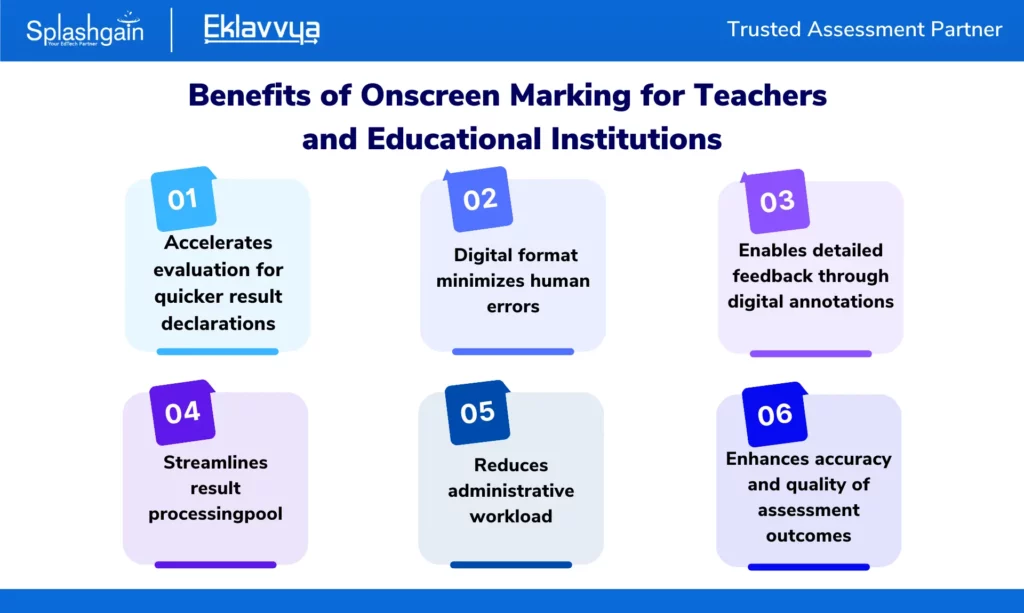
Onscreen marking offers numerous benefits. It expedites the evaluation process, enabling faster result declarations. The digital format reduces the risk of human errors and enhances consistency in marking. It also allows teachers to provide detailed feedback to students through digital annotations.
Educational institutions benefit from streamlined result processing, reduced administrative burdens, and improved accuracy. Onscreen marking not only saves time and resources but also enhances the overall quality of assessment outcomes.
The use of technology for exam management has resulted in a 30% reduction in errors in grading and result processing.

6) Leveraging Exam Analytics for Personalized Feedback
Institutions leveraging exam analytics have seen a 20% improvement in identifying underperforming students and curriculum gaps (Source: eLearning Industry).
The importance of personalized feedback in education
Personalized feedback is a cornerstone of effective education. It recognizes that every student has unique strengths, weaknesses, and learning styles. Tailored feedback not only acknowledges individual progress but also provides specific guidance for improvement. It helps students to take ownership of their learning journey, and enhances their overall engagement and motivation in gaining education.
How exam analytics can provide insights for personalized feedback?
Exam analytics uses Artificial intelligence to provide feedback. It looks at test results, finds patterns in student performances in exams, and figures out where they’re doing well and where they need help. This helps teachers see exactly what each student is good at and where they can do better.
By showing this data in the form of detailed reports, exam analytics helps teachers give feedback that matches each student’s learning style, helping them understand what they’re good at and where they can improve.
A scenario for successful implementation of exam analytics
An example of effective exam analytics involves a university that utilized data from online assessments to enhance student outcomes. By analyzing exam results using sophisticated tools, educators identified recurring difficulties in a specific topic.
With this insight, they modified their teaching strategies, so as to target the identified challenge areas. As a result, student performance improved significantly in subsequent assessments. This case study showcases how exam analytics can lead to improved learning outcomes and better student engagement.
University can also conduct generative AI based assessments. Such exams are interactive and asks questions to the candidate based on his or her previous responses. System also generates comprehensive skill based report which is personlized for each student.
7) Learning Outcomes: The Ultimate Measure of Educational Success
Learning outcomes and their importance
Learning outcomes are the knowledge, skills, and abilities that students are expected to acquire through education. They provide a clear understanding of what students should achieve by the end of a course or program.
Learning outcomes are crucial because they help with curriculum development or modifications, creating educational strategies, and assessment methods. They ensure that teaching objectives and student achievements are aligned to enable teachers to gauge the effectiveness of their teaching practices.
How simplifying examination management can improve learning outcomes?
Simplifying examination management directly impacts the knowledge gained by students. Streamlined processes free up time for educators to focus on teaching and supporting students. When administrative tasks are simplified, educators can dedicate more attention to innovating creative ways of education delivery and assessment.
Such improvement in education delivery positively influences learning outcomes by promoting a more favorable learning environment for student.
The role of technology and data analytics in measuring and improving learning outcomes
Technology and AI driven data analytics play a pivotal role in measuring and improving learning outcomes. Advanced algorithms enable the extraction and analysis of student performance data across assessments. This data-driven approach offers insights into students’ strengths and areas for improvement.
By identifying learning gaps and adapting teaching strategies accordingly, educators can provide feedback that enhance understanding and knowledge retention. Additionally, technology facilitates continuous improvement by enabling educators to track progress and make changes accordingly.
Bonus Strategy: Adopt Generative AI for Assessments
Generative AI is a buzzword for the year 2024. As a forward-looking university, you should adopt generative AI based assessments. Traditional assessments fail to analyze various skills like problem-solving, interpersonal skills, and application-oriented analysis of learning.
Generative AI can provide scenario / case Study/Role-based questions where students need to interact with the Live BOT and answer questions specific to particular case study. AI then evaluate candidate in terms of Breadth of Knowledge, Technical Depth, Response to Follow-up Questions, Practicality, and Problem-Solving Approach.
It can eliminate bias from the assessment process and it can provide personalized feedback to student.

Conclusion
Simplifying university examination management involves a series of strategic steps. It begins with adopting modern technology to create and manage question papers efficiently. Online assessment platforms such as Eklavvya can streamline exam administration, reduce administrative burden, and enable remote proctoring for fair evaluations.
Embracing digital evaluation methods, like onscreen marking (OSM), enhances accuracy and speeds up result processing. Utilizing exam analytics provides valuable insights for decision-making, leading to improved quality of education.
Implementing these steps can transform education for all stakeholders. Students benefit from smoother exam experiences, enhanced security, and quicker result availability. Teachers can redirect their focus from administrative tasks to quality teaching, fostering better engagement and personalized learning. By adopting online exam platforms, educational institutions can witness increased efficiency, reduced operational costs, and an elevated reputation due to streamlined processes and improved student experiences.
The call to embrace these changes is an invitation to create a more efficient and effective examination management system. By adopting modern technology, universities can ensure fair assessments, timely and accurate results, and data-driven improvements.
These changes not only enhance administrative efficiency but also contribute to elevating the overall quality of education. Universities can position themselves as pioneers of educational innovation by taking this opportunity to revolutionize their examination processes and deliver enhanced value to students.
The best practices for online exam management includes several key aspects. Firstly, ensuring a stable and secure internet connection for both students and administrators is crucial to prevent disruptions. Clear communication of exam instructions and technical requirements helps students prepare before the exam. Utilizing reliable online proctoring solutions can maintain exam integrity and prevent cheating. Moreover, adopting an online examination platform can help with seamless conduction of exams.
Online exam management requires a combination of essential tools to ensure a smooth and efficient process. Firstly, a reliable online assessment platform is vital that offers features for question paper creation, test scheduling, and result management. A robust learning management system (LMS) can facilitate seamless integration of exam software with existing courses. Additionally, online proctoring solutions ensure exam integrity by preventing cheating. Finally, AI driven data analytics tools can help educators gain insights into student performance and identify areas for improvement in the online exam process.
Ensuring fairness and accuracy in online exam evaluation cab be achieved through AI technology. AI algorithms can be programmed to eliminate biases by analyzing responses objectively. AI can identify patterns of cheating or irregularities in real-time, enhancing the integrity of the evaluation process. Additionally, AI-powered systems provide consistent and standardized grading and thus minimize human errors. Finally, incorporating advanced AI-driven analytics allows educators to track student performances, leading to continuous improvement in the evaluation process.
Online exams offer many advantages with respect to time and resource-saving compared to traditional paper-based exams. The process of distributing and collecting physical question papers and answer sheets is eliminated and thus administrative workload and costs is reduced . Automated grading and result processing in online exams help to bring down the time needed for evaluation. Moreover, the ability to conduct exams remotely eliminates the need for infrastructure and reduces logistical challenges, leading to further resource saving. Overall, online exams provide a streamlined, efficient and economic way to manage assessments.


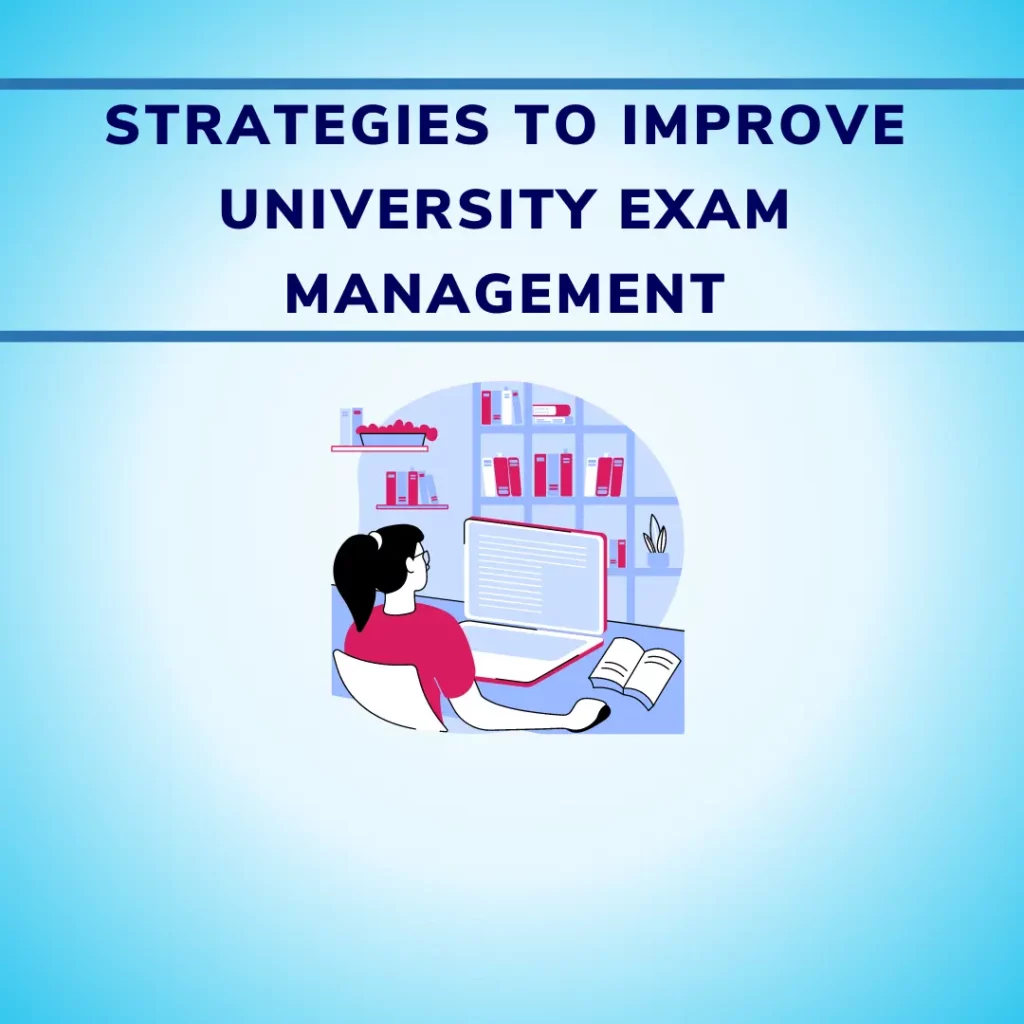

![How Government-Led Exams at 250+ Locations Are Setting New Standards of Integrity [Case Study]](https://www.eklavvya.com/blog/wp-content/uploads/2024/04/Enhancing-Exam-Integrity-Government-Certification-in-250-Locations-150x150.webp)
![Transforming Central Govt. Exams Evaluation: How Onscreen Marking is Leading the Charge [Case Study]](https://www.eklavvya.com/blog/wp-content/uploads/2024/04/How-Onscreen-Marking-Revolutionized-Central-Govt-Exams-Case-Study-1-150x150.webp)
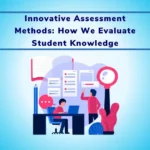
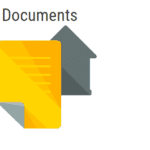











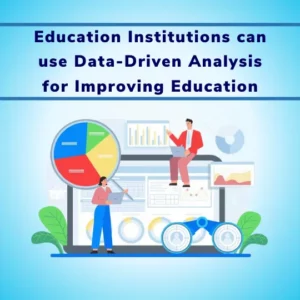

![How Onscreen Marking Revolutionized Central Govt Exams [Case Study]](https://www.eklavvya.com/blog/wp-content/uploads/2024/04/How-Onscreen-Marking-Revolutionized-Central-Govt-Exams-Case-Study-1-300x300.webp)
